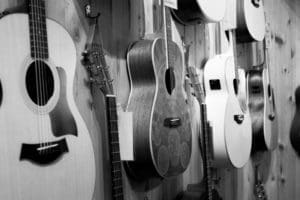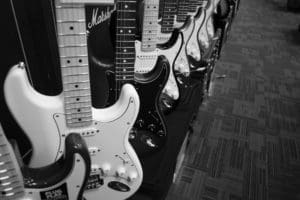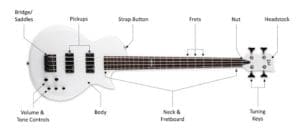Last update 5/2/2024.
Let’s face it – good guitars can be expensive. Real expensive. That can be especially true if you are looking to buy new. But – just as when you may be looking for a new (or ‘new to you) car, there are plenty of good buys to be had if you look at the tons of used guitars on the market.
Table of contents
Where to Buy a Used Guitar
Let’s look at some of the most important things you should consider when considering buying a used guitar.
Condition, condition, condition
As the old saying goes, ‘condition is king.’ If you come across a used guitar in your price range, the most important thing you can do is perform as thorough an inspection as possible.
Evidence of previous damage (and subsequent repairs) can be a red flag. You may come across a model with an incredibly attractive price…but that price might be low for a reason. I would recommend avoiding any used guitar that has, for example, signs that the guitar’s headstock had been cracked or – even worse – broken off altogether.
Excessive wear and tear is another biggie. Any used guitar will most likely have some buckle rash or slight dings and scratches; that’s to be expected. But always take a harder look – are the frets worn down? Do they have grooves in them? Is the finish wearing off in certain spots? Does the finish on the metal hardware show any signs of corrosion?
I remember one of the first gigs I played with that amp was at a local church. They wanted someone to fill in with the guitar and my friend say, ‘Ah, he can play.’ And so I dragged the amplifier down and started playing and everybody started yelling ‘turn it down!’ – Angus Young
There are many things in common to consider when looking at both good acoustic and electric used guitar purchases. You should pay particular attention to some things specific to each type of instrument. ( read more in the FAQ below)
How to buy a used acoustic guitar
An acoustic guitar is typically a more fragile instrument than a solid body electric. Just by the nature of their construction, the body is a prime target for particular kinds of damage since the top, back, and sides are so thin.


Look for signs of cracking. These days, many of the best acoustic guitars – even the less expensive models – have solid tops instead of laminates, which are extremely sensitive to humidity and temperature conditions. A used acoustic that has not been adequately cared for may be dried out and just a few steps away from having a crack that can run across the entire body.
The bridge joint is another area to look for. Ensure that the bridge is glued securely to the top and is not starting to lift. That condition can be caused by exposure to high temps when the guitar is strung up to pitch. The tension that strings place on a guitar is much more than you think it may be, and if any glues have been allowed to soften, you may have a big problem.
Used electric guitars
Most electric guitars are a bit more durable than acoustics, but that doesn’t mean there aren’t things to look for if you’re considering a used model.


First and foremost is the electronics. Here is a simple checklist of things to inspect:
- Do all of the pickups work?
- Do all potentiometers (also called ‘pots’) turn freely?
- Does the volume pot sound scratchy when using it? If so, then the pot may be dirty or ready to fail.
- Is there any excessive humming or buzzing? This may indicate a grounding issue or some other type of wiring problem.
- Do all of the switches operate as they should and do so without any unwanted noise?
Inspecting the hardware is also a prime point, especially if you consider a model with some tremolo bridge system. Ensure the bar travels smoothly and doesn’t have too much (or too little) spring pressure. Also, a significant factor to look for here is tuning stability – it doesn’t make much sense to have a trem bridge if the dang thing won’t stay in tune whenever you use it.
The price is right.
The price of a used guitar can be just as important as the condition. You may run across a near-mint guitar, but if the price isn’t within your budget, there’s not much point in looking any further.
The best guitar advice we can give is to buy the best guitar you can with the budget available. Using the used car analogy again, your budget may limit you to buying a car with a few more miles than you would like. But that’s OK – you have to strike a balance between how good of a guitar you want to be compared to what you can afford.
Should I buy a used guitar online?
With the multitude of online services where you can buy used guitars (Reverb, eBay, Facebook Marketplace, Craigslist, etc.), there certainly is no shortage of places to find that great deal you’ve been looking for.


While that seems convenient, there is a bit of a disadvantage. Sure, you can look at pics to see the overall condition, but there is no substitute for being able to sit down and play it before you lay down your hard-earned cash. That great deal you came across may look great online, but there’s no way to tell how it feels or plays unless you have it in your hands.
That’s not to say you can’t buy a good guitar online. People do it all the time. That being said, our recommendation is to – if at all possible – try before you buy. A local Craigslist or Facebook Marketplace buy may be the best way to give it a quick playthrough before pulling the trigger.
If you do end up buying sight unseen (and the guitar unplayed), the recommendation is to use a payment method where you have some buyer protection. That’s important if things don’t go as smoothly as you would expect them to. ( read more in the FAQ below)
Educate yourself on what you want.
Sad to say, some people out there can be very unethical. They may try to take a junk guitar and sell it as something much more than it is. There are numerous stories around the internet of people doing wicked things, like slapping a Fender logo on the headstock of a super cheap Strat copy and trying to pass it off as the real deal.
Take the time to research so you know what to look for. A little knowledge can go a long way and help you not get duped!


Overall – as the old saying goes -‘ caveat emptor’ (let the buyer beware)…
Conclusion
One parting piece of wisdom: don’t let the possibility of a potentially good deal keep you from seeing what an instrument really is. It’s really easy to get excited and overlook things that will pop up once the honeymoon ends. Try to stay objective as much as you can, as hard as that may be!
Buying a used guitar isn’t nearly as complicated as you may think it can be. All it takes is a little time and effort to do as good of the inspection as possible. Also, do a little research to ensure you know what you’re looking at when that ‘perfect deal’ seems right in front of your eyes.
Transparency disclosure: Some of the links in this post are affiliate links, meaning that I may earn a commission if you click on a link and make a purchase. This commission comes at no extra cost to you. We only recommend products and services that I believe are helpful and valuable, and we never let the potential for a commission influence our recommendations.






Time causes wounds much like anything old. Check the neck for warping, bowing, or twisting (the frets should be aligned and level when you sight down the fretboard). Look for cracks or repair lines because headstocks frequently break. Verify the stability and smooth operation of each tuner. Examine each electronic control. Look for body cracks, decay, or separation of the internal bracing if it’s an acoustic guitar. Check to see if the neck is firmly attached to the body and shows no signs of repair! Knowing the fundamental functions of the guitar and its parts will help you understand the state of the instrument if you’re planning to get your first antique guitar.